Stephan Alaniz
Training-free Uncertainty Guidance for Complex Visual Tasks with MLLMs
Oct 01, 2025Abstract:Multimodal Large Language Models (MLLMs) often struggle with fine-grained perception, such as identifying small objects in high-resolution images or finding key moments in long videos. Existing works typically rely on complicated, task-specific fine-tuning, which limits their generalizability and increases model complexity. In this work, we propose an effective, training-free framework that uses an MLLM's intrinsic uncertainty as a proactive guidance signal. Our core insight is that a model's output entropy decreases when presented with relevant visual information. We introduce a unified mechanism that scores candidate visual inputs by response uncertainty, enabling the model to autonomously focus on the most salient data. We apply this simple principle to three complex visual tasks: Visual Search, Long Video Understanding, and Temporal Grounding, allowing off-the-shelf MLLMs to achieve performance competitive with specialized, fine-tuned methods. Our work validates that harnessing intrinsic uncertainty is a powerful, general strategy for enhancing fine-grained multimodal performance.
SUB: Benchmarking CBM Generalization via Synthetic Attribute Substitutions
Jul 31, 2025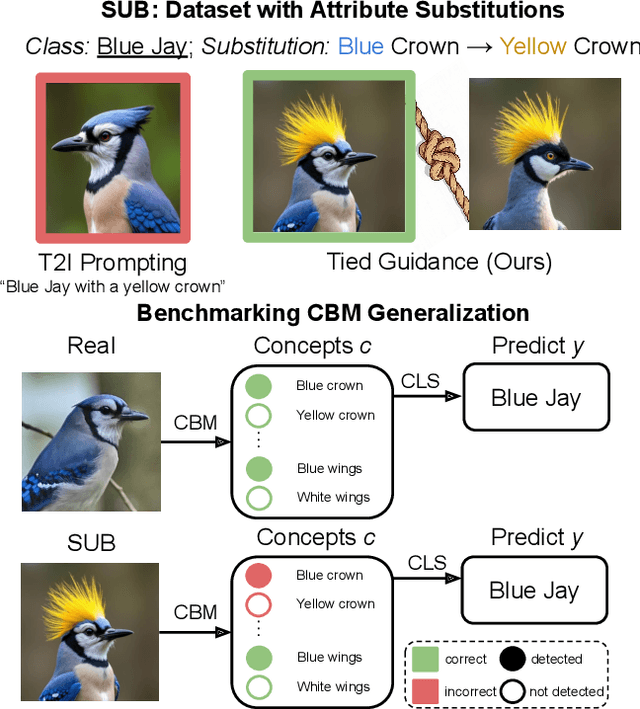
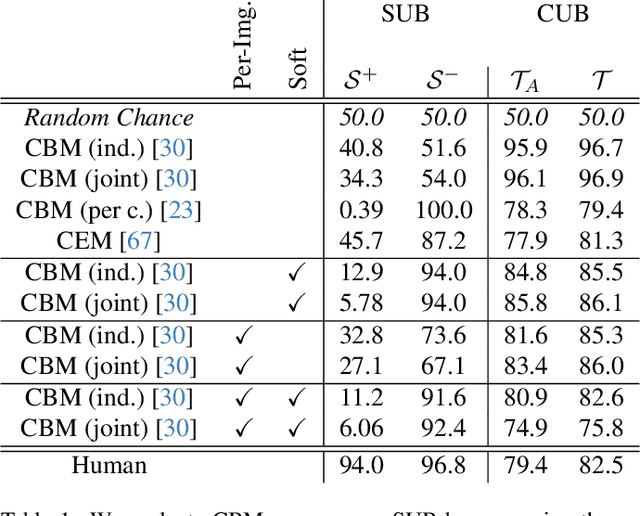
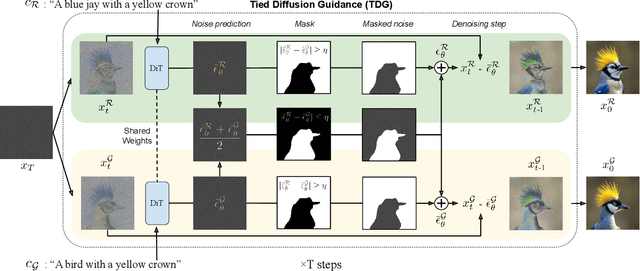

Abstract:Concept Bottleneck Models (CBMs) and other concept-based interpretable models show great promise for making AI applications more transparent, which is essential in fields like medicine. Despite their success, we demonstrate that CBMs struggle to reliably identify the correct concepts under distribution shifts. To assess the robustness of CBMs to concept variations, we introduce SUB: a fine-grained image and concept benchmark containing 38,400 synthetic images based on the CUB dataset. To create SUB, we select a CUB subset of 33 bird classes and 45 concepts to generate images which substitute a specific concept, such as wing color or belly pattern. We introduce a novel Tied Diffusion Guidance (TDG) method to precisely control generated images, where noise sharing for two parallel denoising processes ensures that both the correct bird class and the correct attribute are generated. This novel benchmark enables rigorous evaluation of CBMs and similar interpretable models, contributing to the development of more robust methods. Our code is available at https://github.com/ExplainableML/sub and the dataset at http://huggingface.co/datasets/Jessica-bader/SUB.
Feasibility with Language Models for Open-World Compositional Zero-Shot Learning
May 16, 2025Abstract:Humans can easily tell if an attribute (also called state) is realistic, i.e., feasible, for an object, e.g. fire can be hot, but it cannot be wet. In Open-World Compositional Zero-Shot Learning, when all possible state-object combinations are considered as unseen classes, zero-shot predictors tend to perform poorly. Our work focuses on using external auxiliary knowledge to determine the feasibility of state-object combinations. Our Feasibility with Language Model (FLM) is a simple and effective approach that leverages Large Language Models (LLMs) to better comprehend the semantic relationships between states and objects. FLM involves querying an LLM about the feasibility of a given pair and retrieving the output logit for the positive answer. To mitigate potential misguidance of the LLM given that many of the state-object compositions are rare or completely infeasible, we observe that the in-context learning ability of LLMs is essential. We present an extensive study identifying Vicuna and ChatGPT as best performing, and we demonstrate that our FLM consistently improves OW-CZSL performance across all three benchmarks.
Concept-Guided Interpretability via Neural Chunking
May 16, 2025Abstract:Neural networks are often black boxes, reflecting the significant challenge of understanding their internal workings. We propose a different perspective that challenges the prevailing view: rather than being inscrutable, neural networks exhibit patterns in their raw population activity that mirror regularities in the training data. We refer to this as the Reflection Hypothesis and provide evidence for this phenomenon in both simple recurrent neural networks (RNNs) and complex large language models (LLMs). Building on this insight, we propose to leverage cognitively-inspired methods of chunking to segment high-dimensional neural population dynamics into interpretable units that reflect underlying concepts. We propose three methods to extract these emerging entities, complementing each other based on label availability and dimensionality. Discrete sequence chunking (DSC) creates a dictionary of entities; population averaging (PA) extracts recurring entities that correspond to known labels; and unsupervised chunk discovery (UCD) can be used when labels are absent. We demonstrate the effectiveness of these methods in extracting entities across varying model sizes, ranging from inducing compositionality in RNNs to uncovering recurring neural population states in large models with diverse architectures, and illustrate their advantage over other methods. Throughout, we observe a robust correspondence between the extracted entities and concrete or abstract concepts. Artificially inducing the extracted entities in neural populations effectively alters the network's generation of associated concepts. Our work points to a new direction for interpretability, one that harnesses both cognitive principles and the structure of naturalistic data to reveal the hidden computations of complex learning systems, gradually transforming them from black boxes into systems we can begin to understand.
LoFT: LoRA-fused Training Dataset Generation with Few-shot Guidance
May 16, 2025Abstract:Despite recent advances in text-to-image generation, using synthetically generated data seldom brings a significant boost in performance for supervised learning. Oftentimes, synthetic datasets do not faithfully recreate the data distribution of real data, i.e., they lack the fidelity or diversity needed for effective downstream model training. While previous work has employed few-shot guidance to address this issue, existing methods still fail to capture and generate features unique to specific real images. In this paper, we introduce a novel dataset generation framework named LoFT, LoRA-Fused Training-data Generation with Few-shot Guidance. Our method fine-tunes LoRA weights on individual real images and fuses them at inference time, producing synthetic images that combine the features of real images for improved diversity and fidelity of generated data. We evaluate the synthetic data produced by LoFT on 10 datasets, using 8 to 64 real images per class as guidance and scaling up to 1000 images per class. Our experiments show that training on LoFT-generated data consistently outperforms other synthetic dataset methods, significantly increasing accuracy as the dataset size increases. Additionally, our analysis demonstrates that LoFT generates datasets with high fidelity and sufficient diversity, which contribute to the performance improvement. The code is available at https://github.com/ExplainableML/LoFT.
A Large Scale Analysis of Gender Biases in Text-to-Image Generative Models
Mar 30, 2025Abstract:With the increasing use of image generation technology, understanding its social biases, including gender bias, is essential. This paper presents the first large-scale study on gender bias in text-to-image (T2I) models, focusing on everyday situations. While previous research has examined biases in occupations, we extend this analysis to gender associations in daily activities, objects, and contexts. We create a dataset of 3,217 gender-neutral prompts and generate 200 images per prompt from five leading T2I models. We automatically detect the perceived gender of people in the generated images and filter out images with no person or multiple people of different genders, leaving 2,293,295 images. To enable a broad analysis of gender bias in T2I models, we group prompts into semantically similar concepts and calculate the proportion of male- and female-gendered images for each prompt. Our analysis shows that T2I models reinforce traditional gender roles, reflect common gender stereotypes in household roles, and underrepresent women in financial related activities. Women are predominantly portrayed in care- and human-centered scenarios, and men in technical or physical labor scenarios.
Discovering Chunks in Neural Embeddings for Interpretability
Feb 03, 2025Abstract:Understanding neural networks is challenging due to their high-dimensional, interacting components. Inspired by human cognition, which processes complex sensory data by chunking it into recurring entities, we propose leveraging this principle to interpret artificial neural population activities. Biological and artificial intelligence share the challenge of learning from structured, naturalistic data, and we hypothesize that the cognitive mechanism of chunking can provide insights into artificial systems. We first demonstrate this concept in recurrent neural networks (RNNs) trained on artificial sequences with imposed regularities, observing that their hidden states reflect these patterns, which can be extracted as a dictionary of chunks that influence network responses. Extending this to large language models (LLMs) like LLaMA, we identify similar recurring embedding states corresponding to concepts in the input, with perturbations to these states activating or inhibiting the associated concepts. By exploring methods to extract dictionaries of identifiable chunks across neural embeddings of varying complexity, our findings introduce a new framework for interpreting neural networks, framing their population activity as structured reflections of the data they process.
FLAIR: VLM with Fine-grained Language-informed Image Representations
Dec 04, 2024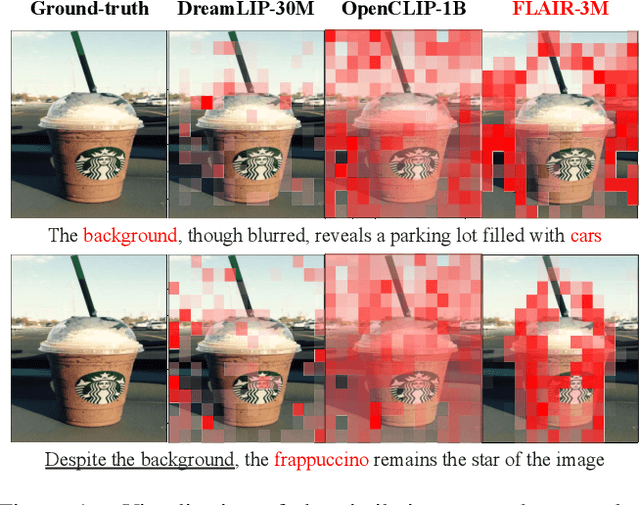
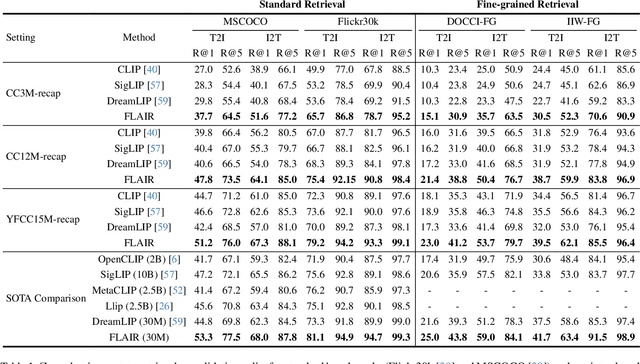

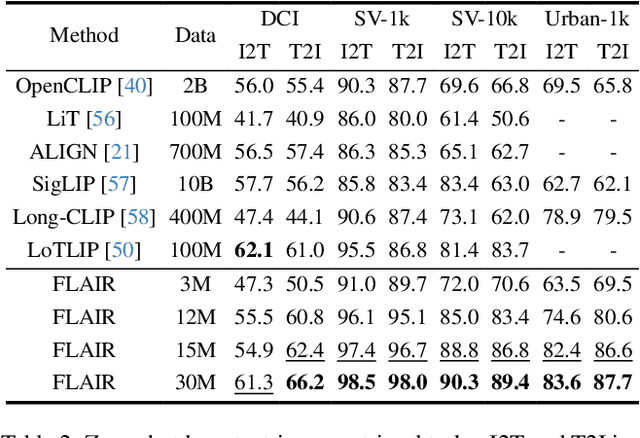
Abstract:CLIP has shown impressive results in aligning images and texts at scale. However, its ability to capture detailed visual features remains limited because CLIP matches images and texts at a global level. To address this issue, we propose FLAIR, Fine-grained Language-informed Image Representations, an approach that utilizes long and detailed image descriptions to learn localized image embeddings. By sampling diverse sub-captions that describe fine-grained details about an image, we train our vision-language model to produce not only global embeddings but also text-specific image representations. Our model introduces text-conditioned attention pooling on top of local image tokens to produce fine-grained image representations that excel at retrieving detailed image content. We achieve state-of-the-art performance on both, existing multimodal retrieval benchmarks, as well as, our newly introduced fine-grained retrieval task which evaluates vision-language models' ability to retrieve partial image content. Furthermore, our experiments demonstrate the effectiveness of FLAIR trained on 30M image-text pairs in capturing fine-grained visual information, including zero-shot semantic segmentation, outperforming models trained on billions of pairs. Code is available at https://github.com/ExplainableML/flair .
COSMOS: Cross-Modality Self-Distillation for Vision Language Pre-training
Dec 02, 2024Abstract:Vision-Language Models (VLMs) trained with contrastive loss have achieved significant advancements in various vision and language tasks. However, the global nature of contrastive loss makes VLMs focus predominantly on foreground objects, neglecting other crucial information in the image, which limits their effectiveness in downstream tasks. To address these challenges, we propose COSMOS: CrOSs-MOdality Self-distillation for vision-language pre-training that integrates a novel text-cropping strategy and cross-attention module into a self-supervised learning framework. We create global and local views of images and texts (i.e., multi-modal augmentations), which are essential for self-distillation in VLMs. We further introduce a cross-attention module, enabling COSMOS to learn comprehensive cross-modal representations optimized via a cross-modality self-distillation loss. COSMOS consistently outperforms previous strong baselines on various zero-shot downstream tasks, including retrieval, classification, and semantic segmentation. Additionally, it surpasses CLIP-based models trained on larger datasets in visual perception and contextual understanding tasks.
Revealing and Reducing Gender Biases in Vision and Language Assistants (VLAs)
Oct 25, 2024



Abstract:Pre-trained large language models (LLMs) have been reliably integrated with visual input for multimodal tasks. The widespread adoption of instruction-tuned image-to-text vision-language assistants (VLAs) like LLaVA and InternVL necessitates evaluating gender biases. We study gender bias in 22 popular open-source VLAs with respect to personality traits, skills, and occupations. Our results show that VLAs replicate human biases likely present in the data, such as real-world occupational imbalances. Similarly, they tend to attribute more skills and positive personality traits to women than to men, and we see a consistent tendency to associate negative personality traits with men. To eliminate the gender bias in these models, we find that finetuning-based debiasing methods achieve the best tradeoff between debiasing and retaining performance on downstream tasks. We argue for pre-deploying gender bias assessment in VLAs and motivate further development of debiasing strategies to ensure equitable societal outcomes.
 Add to Chrome
Add to Chrome Add to Firefox
Add to Firefox Add to Edge
Add to Edge